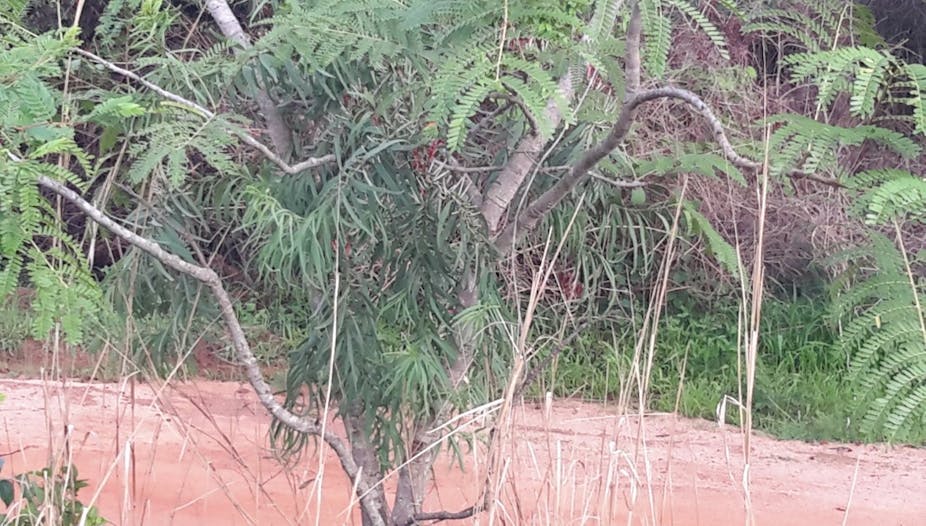Mistletoes are found in a wide range of forest ecosystems. As parasites, they are a fascinating group of plants. They get their nutrition from host plants and are ecosystem engineers, making an impact along food chains.
They affect population dynamics, diversity, and distributions of other plants as well as invertebrates, birds and mammals. Their broad geographic distributions, and their long and unique flowering and fruiting periods, make them an attractive resource for wildlife. The fruit and nectar are food for birds, which also nest and roost on the plant, providing pollination and seed dispersal services in the process.
In West Africa, mistletoes are found on many indigenous trees and several tree crops of economic importance. These hosts include shea, neem, sweet orange, cocoa, rubber and the African locust bean tree.
The African locust bean (Parkia biglobosa) is regarded as an important tree crop, used for medicine and food. The trees also play a valuable role in nutrient cycling by fixing atmospheric nitrogen in soils. They are susceptible to mistletoe infection and agroforestry managers usually eradicate the parasitic plant.
But if mistletoes provide food and shelter for species that are particularly important in an ecosystem, then removing them might not be a good strategy.
We therefore investigated an aspect of mistletoe’s ecological benefits that was not well researched. We studied how birds use mistletoes that grow on P. biglobosa in Amurum Forest Reserve, Nigeria, across its mosaic of habitats.
We recorded all visits by birds to trees with mistletoe: when they visited, how long they spent in the trees and how they behaved. As predicted, Tapinanthus dodoneifolius mistletoes on P. biglobosa were an important provider of food and shelter for birds. In addition, the ecological role of this mistletoe on P. biglobosa in times of food scarcity, especially in the dry season, appears important.
This broader understanding of mistletoe significance and ecology could inform any action in the management of African locust bean forests, and in conservation.
Our research
We carried out our study in Amurum Forest Reserve in Jos, Plateau State, central Nigeria. The reserve has three major habitat types, differing in plant species. It has about 278 bird species, 31% of the total recorded in Nigeria. This makes it one of Nigeria’s biodiversity hotspots.
Some of the plant species, including P. biglobosa, in the reserve host mistletoes, attached to their stem as parasites. The locust bean trees in the study area are infected by three mistletoe species: Tapinanthus dodoneifolius, T. bangwensis and T. sesselifolius.
Only T. dodoneifolius was fruiting during our study, so we only observed birds visiting this species.
The Amurum Forest Reserve had a relatively high density of mistletoe-infected P. biglobosa trees. Of 663 trees, 398 (60%) were parasitised with T. dodoneifolius mistletoes and 265 (40%) were not. Ninety-four (14.2%) of the total number of trees were recorded in the rocky habitat, with 49 infected and 45 non-infected. Seventy-one (10.7%) of the total were in the gallery forest, with 59 infected and 12 non-infected. We recorded 498 (75.1%) of the total in the savanna, with 290 infected and 208 non-infected.
In 432 hours of observations, we recorded 725 individual birds, comprising 71 species, and belonging to 31 families and four orders, visiting both the locust bean trees and their associated T. dodoneifolius mistletoes. Fruit eaters, insect eaters, nectar feeders and omnivores all visited mistletoe flowers or fruits on the locust bean trees. A total of 352 individual bird visits (from 54 species) were recorded directly on the mistletoes.
The rate of mistletoe infection on the trees in our study did not differ significantly across habitat types. This suggests that the probability of infection does not depend on habitat type but might be related to host plant quality, host availability and bird behaviour.
Bird use of mistletoes on locust bean trees
Our findings corroborate the host quality hypothesis: mistletoes favour nitrogen-fixing and leguminous plants as hosts.
Bird species in our study had similar chances of accessing all habitat types. Therefore, they could move seeds from one habitat to another to an available host. This supports larger numbers of birds and increases the chances that the mistletoe and the host plant’s fruits will be dispersed.
The number of mistletoes on the host plant also determines birds’ preferences for particular trees (measured as time spent by birds on plants in a tree), as found in other studies. Birds were attracted to a dense build-up of berries of T. dodoneifolius mistletoes on the host and tended to spend a lot of time feeding on them, thereby enhancing dispersal. Mistletoes do not all produce fruit or ripen at the same time. Fruit dispersers therefore find their fruit reward available all year round in some species or at times of general food scarcity.
We observed that the height of the host tree and the number of mistletoes on it influenced the bird activity. Aside from eating fruit, we also saw birds perching, pecking, and foraging on insects, seeds, leaves, and nectar on both the mistletoe and host. This benefits the bird, mistletoe and host.
Implications of our findings
Our study supported the idea we started with – that T. dodoneifolius mistletoes on locust bean trees are a keystone producer, based on the bird species use and visitation. Keystone producers are species that have a large impact or influence on the ecosystem. These mistletoes on the trees appear to have an important role in times of food scarcity, especially in the dry season. They are important resources for birds in the reserve.
Understanding relationships like these can help identify critical resources and potential keystone species to inform conservation planning. Reforestation programmes should consider the parasitic relationship between mistletoes and their hosts and their ecological benefits for bird diversity, fruit dispersal and pollination, and ultimately ecosystem stability.

